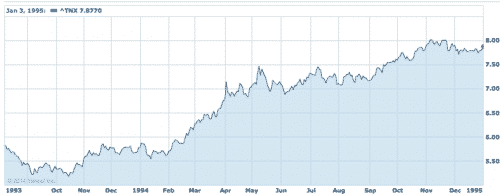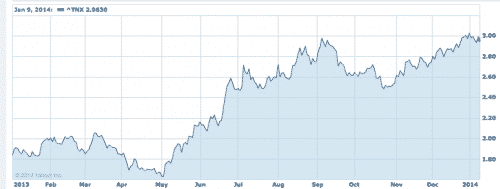2013 as 1994
Quick note before I get into today’s commentary. Recently, I became the producer/writer for a finance and economics show on RT called Boom Bust. I wanted to do a little plug for the show here because I won’t be talking about it that much as we go forward since I plan to keep those duties separate from my newsletter and blog. But I will be on the show daily and you can see clips here on YouTube. Many of the other writers here on Credit Writedowns will feature on the show as interviewees and also expect to see many of the other finance bloggers on as well. It should be good. Now on to the commentary
Today’s commentary
With the Fed keeping rates near zero percent in the US, most investors are expecting 2014 to be a good year economically and for this to translate into a good year for investing. But, we are uncharted waters because we have never been deep into a business cycle with rates at zero or with no chance of a Fed hike on the horizon. It is difficult, therefore to compare this cycle to past cycles. I see comparisons to the 1990s cycle however and I want to lay out a case for seeing 2013 as similar to 1994. This could be an especially difficult transition for bond markets though.
The fact that overnight rates are at zero percent and that the Fed has no intention of hiking them anytime soon is a major departure from previous cycles. In the era after World War 2, traditionally the economy has begun to overheat, forcing the Fed’s hand and eventually the economy ebbs again, precipitating a Fed move in the opposite direction.
For example in the early 1990s, we had a jobless recovery for the first time. And this led the Fed to cut rates drastically. 10-year treasury yields fell from 9% in July 1990 when recession was beginning all the way down to just over 5% in late 1993. When the demand for credit kicked in, this was a powerful incentive for borrowers to take on debt. And a boom began. The Fed then began tightening in 1994 and this took the markets by surprise. Bond markets tumbled and yields backed up, making 1994 one of the worst years for bond markets in a generation.
This time it is slightly different. If we used a traditional monetary policy tool like the Taylor rule to gauge where the Fed should be, interest rates would start rising in mid-2014, reaching nearly 3% by the end of 2015 according to Benjamin Mandel of Citigroup. We are nowhere near that hawkish. The Fed has only just begun tapering large scale asset purchases. Hikes won’t come for some time to come. What’s an investor to do with that signal?
If you loaded up on long duration bonds in 2013, thinking this was a general risk-on signal, you got crushed.
So it wasn’t just risk on. I have started to say that tapering is tightening because it is clear that bonds have backed up not just because the economy has improved durably but also because the term premium has begun to shift. And so the steepening of the yield curve has begun just as a monster rally in equities has done. A lot of people called this a rotation out of bonds into equities. But the numbers do not support this claim. Instead, what has happened has more to do with what I explained regarding tightening into frothy markets. “When central banks tighten into a frothy asset market psychology, the effect is the opposite of what traditional economics would dictate.” Since markets now are frothy, higher rates could potentially bring forward credit demand so that agents seeking credit can lock in to rates before they rise. This is an accelerator of the economy. Moreover, the addition of interest income because of QE tapering and higher rates act as further accelerants. In short, while we call this tightening, I believe increased rates are business cycle accelerants.
This has me looking at 2013 as being akin to 1994. After a long and jobless technical recovery, the credit cycle had turned enough to where the Fed felt it could begin to tighten. In 1994, it hiked. In 2013, the Fed tapered asset purchases. The response in markets was a sell off in long duration fixed income assets but not a decline in duration assets more generally. Instead, we are seeing an asset class risk re-weighting with the term premium increasing risk in long duration fixed income while the lack of rate hikes is decreasing the risk in other long duration assets like equities and high yield. The S&P500 is at record levels and the AAA/BAA credit spread is only 79 bpts.
What does this mean for 2014 then? Well, the jobs numbers have just come in – and they were very weak +74,000 on non-farm payrolls, -13,000 from government and +87,000 from the private sector. The key, however, is that the unemployment rate dropped to 6.7% because of the record low 62.8% labor participation rate. We are a hair away from 6.5% unemployment. If the US Congress does not extend unemployment benefits, the unemployment rate is going down to 6.5% in January because of labor participation. And the Fed is not going to change the Evans Rule i.e the 6.5% unemployment threshold to 6.0% – there is no consensus for that with Plosser, George, and Fisher. Moreover, enhanced forward guidance is a farce – a non-policy. The Fed tried to finesse the Evans rule last month by saying it would stay easy well beyond the 6.5% unemployment threshold. But that’s simply not very good guidance and it will look increasingly opaque once we hit 6.5% unemployment. This is why I had recommended a deflationary threshold floor like Bullard.
My view here then is that tapering plus reaching through the 6.5% unemployment threshold is bond bearish. The Fed has allowed the Evans Rule to become superfluous. And so we are at the point where the Fed has a de facto tightening bias. That is going to cause expectations for a hike to move forward and yields to back up further. This is bearish for bonds. The question is how will equities and high yield react. If the real economy holds and the pace of job growth holds, then the backup in yields will simply add an accelerant by pushing forward credit demand. That is generally bullish for equities and high yield.
So I believe we are in frothy market territory. The real economy will be responding to tightening in the opposite way expected. Higher yields will push forward demand for credit and lead to higher prices on junk and potentially also in equities. Meanwhile the yield curve will steepen, adding to bank net interest margins, bolstering their earnings, stock prices and loosening credit standards. All in all, I see the risk in 2014 to the upside.


Comments are closed.